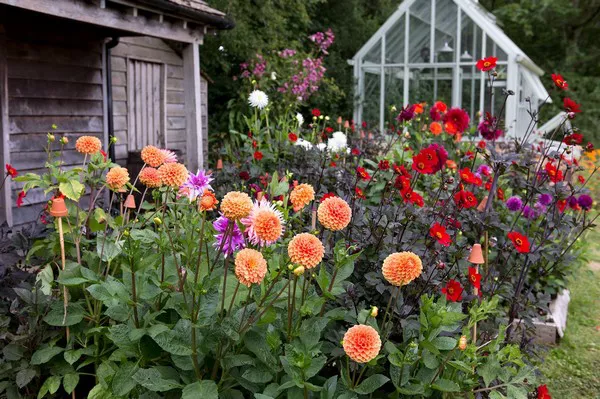Gardening enthusiasts often face the challenge of finding suitable flowers for areas with limited sunlight. Fortunately, there is a diverse array of flowers that not only tolerate shade but flourish in it, bringing vibrant colors and beauty to shaded gardens.
Impatiens (Impatiens walleriana)
Impatiens, commonly known as busy lizzies, are renowned for their ability to thrive in shade. These annual flowers offer a spectrum of colors, including shades of pink, red, orange, and white. With their mounding growth habit, impatiens make excellent ground covers and are ideal for shaded areas where other flowers might struggle. They bloom profusely throughout the growing season, providing continuous color in the garden.
Astilbe (Astilbe spp.)
Astilbes are perennial flowers celebrated for their feathery, plume-like blooms and elegant foliage. Thriving in partial to full shade, these flowers are available in various shades such as pink, red, and white. Astilbes are also valued for their ability to add texture and dimension to shade gardens. They prefer consistently moist soil, making them well-suited for planting alongside other shade-loving plants.
Bleeding Heart (Dicentra spectabilis)
The charming bleeding heart, with its unique heart-shaped flowers, is a classic choice for shaded gardens. These perennials produce arching stems adorned with dangling pink or white blooms that resemble delicate jewelry. Bleeding hearts prefer partial to full shade and well-drained soil. Their distinctive appearance and graceful demeanor make them a standout addition to shaded borders and woodland gardens.
Lungwort (Pulmonaria spp.)
Lungwort, known for its distinctive spotted leaves and tubular flowers, is a shade-loving perennial that adds visual interest to garden spaces. The flowers of lungwort come in shades of blue, pink, and purple and often change color as they mature. These hardy plants thrive in moist, well-drained soil and are particularly well-suited for woodland gardens or shaded areas with dappled sunlight.
Hosta (Hosta spp.)
Hostas are renowned for their lush foliage and adaptability to shade, making them popular choices for shaded landscapes. While hostas are not primarily grown for their flowers, their foliage comes in a variety of shapes, sizes, and colors, including shades of green, blue, and variegated patterns. Planting different hosta varieties can create a visually appealing tapestry in shaded gardens.
Coral Bells (Heuchera spp.)
Coral bells, also known as heucheras, are versatile perennials that thrive in partial shade. Known for their attractive foliage, which comes in a range of colors from deep burgundy to lime green, coral bells also produce delicate spikes of small bell-shaped flowers. These flowers attract pollinators and add a touch of elegance to shaded garden beds and borders.
Toad Lily (Tricyrtis spp.)
Toad lilies are unique and exotic-looking flowers that thrive in shaded conditions. With their orchid-like blooms adorned with intricate patterns, toad lilies bring a touch of the extraordinary to shaded gardens. They prefer consistently moist soil and are well-suited for planting in woodland settings or alongside other shade-loving perennials.
Foxglove (Digitalis purpurea)
Foxgloves are biennial or short-lived perennial flowers that can add vertical interest to shaded gardens. Their tall spikes bear tubular flowers in shades of pink, purple, white, and sometimes speckled patterns. Foxgloves prefer partial shade and well-drained soil. While they are known for their stunning appearance, it’s essential to note that all parts of the plant are toxic if ingested, so caution is advised, especially in households with pets or small children.
Lily of the Valley (Convallaria majalis)
Lily of the Valley is a classic and fragrant perennial that thrives in shaded areas. With its dainty, bell-shaped flowers and lush green foliage, this perennial ground cover adds a touch of elegance to woodland gardens. Lily of the Valley spreads by rhizomes, forming dense carpets of foliage and delicate blooms in the spring.
Japanese Anemone (Anemone hupehensis)
Japanese anemones are resilient perennials that thrive in partial shade to full shade. Their graceful, nodding blooms come in shades of pink and white, adding a sense of movement to shaded garden spaces. Japanese anemones are late-season bloomers, extending the floral display into the fall when many other flowers have finished flowering.
Begonia (Begonia spp.)
Begonias are versatile annual or perennial flowers that excel in shaded conditions. With their wide range of forms and colors, including shades of red, pink, and white, begonias offer a wealth of options for shaded gardens. Tuberous begonias, in particular, are valued for their large, showy blooms. Begonias are well-suited for container gardening in shaded patios or as bedding plants in garden beds.
Columbine (Aquilegia spp.)
Columbines are charming perennials that thrive in partial shade to full shade. Known for their unique spurred flowers, columbines come in a variety of colors, including shades of blue, purple, pink, and white. These versatile plants are well-suited for shaded borders, woodland gardens, and cottage-style landscapes.
Conclusion
Creating a vibrant and flourishing garden in shaded areas is not only possible but also an opportunity to explore a diverse range of flowers that thrive in these conditions. From the classic elegance of lily of the valley to the exotic allure of toad lilies, shade-loving flowers bring a unique charm to garden spaces. By understanding the preferences and characteristics of these flowers, gardening enthusiasts can design captivating landscapes that celebrate the beauty of shaded environments. Embrace the possibilities that shade-loving flowers offer, and transform your garden into a haven of color, texture, and natural splendor.


